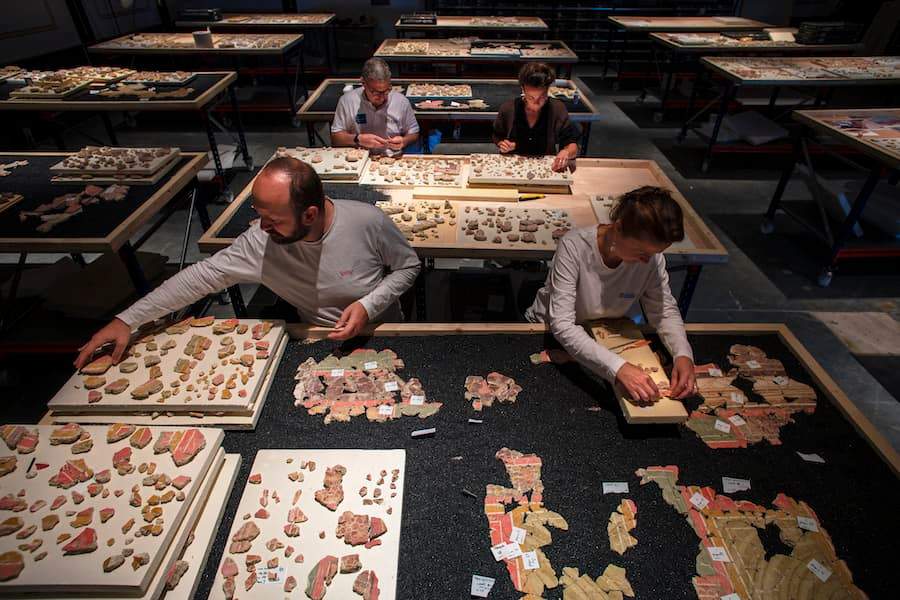Between 2014 and 2017, thousands of fragments of frescoes, a total of eight hundred cases, that decorated the walls were discovered in the Maison de la Harpiste at the site of La Verrerie in Arles. The site of La Verrerie, located on the right bank of the Rhone, was acquired in 1978 by the city of Arles, and numerous excavations have revealed rich domus abandoned due to a fire in 260 AD.
The Maison de la Harpiste owes its name to one of the figures painted on its walls; it is a luxurious Roman residence and is notable for the extraordinary state of preservation of its walls. It was built in the years 70-50 B.C. using Roman construction techniques. The atrium includes a rainwater collection tank and several rooms face it, two of which have been completely excavated. The first room was probably a dining room or bedroom; the second room, largely open to the atrium and with sumptuous painted decoration, was most likely a reception room.
As part of a collaboration with Inrap - the National Institute for Preventive Archaeological Research, the Departmental Museum of Ancient Arles has devoted itself to the study and restoration of the fragments found: a task entrusted to Julien Boislève, a mural and stucco specialist at Inrap, in collaboration with archaeologists and restorers from the museum.
Also underway since April 2021 is a work of utmost precision: the reconstruction of the frescoes by assembling the thousands of fragments found, like a jigsaw puzzle. This huge reassembly project is taking place in the museum’s temnporanee exhibition hall, where the fragments are distributed over more than 220 square meters: over the months, the team has therefore managed to resurface faces, columns, hunting scenes and other figures with almost intact colors. At this stage of study, at least six decorations have been recognized, testifying to the luxury flaunted by the owner. These are paintings that refer to the second Pompeian style. The first room features architecturally inspired furniture that divides the room into two distinct rooms (antechamber and alcove). Typical of this second Pompeian style, the ornamentation imitates an architecture of large apparatus. It has a predominantly yellow antechamber and an alcove embellished with more elaborate ornamentation and sparkling daolors. In the antechamber, the lower part of the wall imitates a gray marble podium supporting heavy yellow columns, while rows of colored blocks occupy the upper part. In the alcove, the brightly colored podium is embellished with rosettes traced in burgundy red. Rich faux-marble panels occupy the central area, surmounted by rows of equally shimmering blocks and within which is inserted a delicate frieze of hunting loves. This type of decoration corresponds to the only model of the second style so far found in Gaul. The paintings in the ceremonial hall will be studied in 2022. They include another type of decoration still unknown in Gaul: a gallery of large figures, including the harpist, positioned on pedestals and emerging against a vermilion-red background. The musician is accompanied by other figures belonging to the Bacchic procession.
“We never imagined that we would find paintings in such a state of preservation,” commented Marie-Pierre Rothé, an archaeologist at the MDAA and head of the operation. “This house was built between 70 and 50 BC even before the creation of the Roman colony of Arles. It is therefore an exceptional discovery in several respects, as it allows us, beyond the archaeological dimension, to learn more about what took place at that time on the right bank of the Rhone. We know that the owner was very wealthy and that he brought craftsmen directly from Italy, because no one at that time had yet mastered these techniques.”
The study will continue in Camargue, at the Château d’Avignon, where teams of archaeologists will reconstruct two complete rooms of the Maison de la Harpiste. It will then be restorers who will integrate them into the museum’s permanent collections by 2026.
 |
| Arles, thousands of fragments pieced together like a jigsaw puzzle: frescoes from the House of the Harpist return to light |
Warning: the translation into English of the original Italian article was created using automatic tools. We undertake to review all articles, but we do not guarantee the total absence of inaccuracies in the translation due to the program. You can find the original by clicking on the ITA button. If you find any mistake,please contact us.